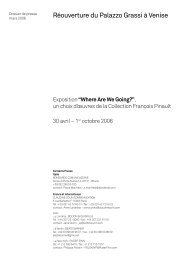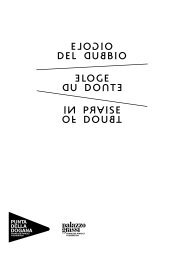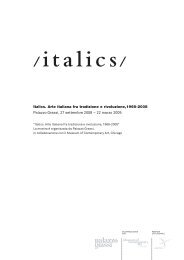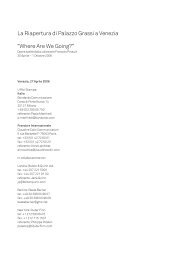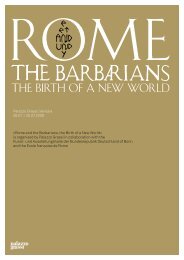pdf file, 1,19 Mb - Palazzo Grassi
pdf file, 1,19 Mb - Palazzo Grassi
pdf file, 1,19 Mb - Palazzo Grassi
You also want an ePaper? Increase the reach of your titles
YUMPU automatically turns print PDFs into web optimized ePapers that Google loves.
artistic media and languages: after all, Jasper Johns and Andy Warhol had shared the stage with<br />
minimalist artists like Donald Judd and Richard Serra, Joseph Beuys with painters like Sigmar Polke<br />
and Gerhard Richter. However, when the return to painting occurred in Italy, it was experienced as a sort<br />
of revenge of superficiality over the oppressing political ideologies of the seventies. At the end of the<br />
seventies, visionary artists such as Alighiero Boetti saw painting as a betrayal of the revolutionary<br />
artistic and political ideals generated by the <strong>19</strong>68 movement. To paint or not to paint is the question<br />
haunting every Italian artist. To paint means to be detached from reality; to occupy a position regarded<br />
with suspicion, if not contempt, by practitioners of Arte Povera. But to paint, as to worship, appears to be<br />
an absolute necessity for the Italian subject. It is no accident that in the mid-eighties, an art world<br />
mesmerized by the wild comeback of painting in all its most perverse manifestations, even most Arte<br />
Povera artists were perceived as painters in their own peculiar way. However, Boetti resisted and never<br />
indulged in painting, immunized by his passion for drawing, a medium that allows chronicling of the<br />
present through direct involvement of the hand. Marisa Merz took the same path, alternating sculpture<br />
and drawing to avoid the trap of the canvas. Still, painting remains one of the two big Mammas of Italian<br />
culture. If religion and the influence of the Vatican have always delayed the development of modern<br />
Italian culture, painting and the Renaissance delayed the free movement and renewal of contemporary<br />
art. The denial of painting and religion in the seventies created traumas that have stopped a clear<br />
understanding of Italy in the last forty years.<br />
“Italics” has put Italian art on the analyst’s couch in order to understand a history which has been<br />
constructed on denial. That denial appears as a political travesty, as in Togliatti’s Funeral, by Renato<br />
Guttuso, in which a local hero is ignored by the rest of the world yet beatified by the shadow church of the<br />
Italian Communist Party. This denial also covered social wounds like the Mafia, which could be<br />
symbolized by the black abstraction of Burri’s “cretto” or by brutal documents such as the photographs<br />
of Letizia Battaglia, classics comparable to those of the American Weegee. The denial has morphed into<br />
a society of glamour and spectacle, which has transformed the television networks into the only real<br />
context accepted by Italy’s contemporary society. Francesco Vezzoli’s early videos are a desperate<br />
attempt to rescue the melancholic memory of a more humane entertainment through a cameo<br />
performance by Franca Valeri, one of the most popular actresses of the early days of Italian public<br />
television. The denial implicit in the fatal confusion of experimental art with the mere aesthetics of<br />
entropic indulgence has simply served the marketing stereotype of “Italian elegance;” it has trapped<br />
phenomenal artists like Dadamaino, Enrico Castellani, Getulio Alviani, and Carla Accardi in formalism,<br />
curbing their attempts to compete with their colleagues across the Atlantic in the territory of<br />
minimalism. The underclass narrated and idealized by Pier Paolo Pasolini has been gentrified, moving<br />
from urban shantytown to anonymous and alienating suburban apartment buildings (such as might<br />
contain the small, depressing kitchen occupied by Maurizio Cattelan’s suicidal squirrel). The denial of a<br />
local bohemia has prevented artists like Carol Rama from becoming the Louise Bourgeois of Italy. The<br />
blackmail of the “body perfect” put at risk by food is clearly manifest in Vanessa Beecroft’s drawings,<br />
which more effectively chart the haunting presence of anorexia than does the embarrassingly clichéd<br />
spectacle of Oliviero Toscani’s advertisement featuring a young woman reduced to a skeleton. The<br />
denial of psychiatric demagogy has transformed artists such as Carlo Zinelli into clinical case studies,<br />
while eccentric people like Raymond Pettibone star in galleries and museums around the world. This is<br />
10






